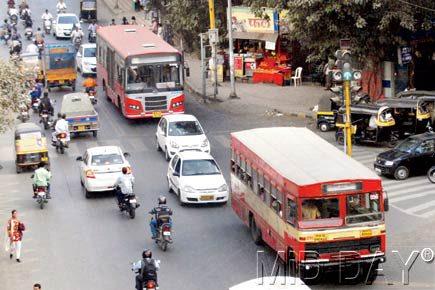To streamline vehicular movement in Pune, the synchronised traffic signal plan has been implemented on thoroughfares, like Tilak Road, Karve Road and Senapati Bapat Road.

Moving on: The advantage of this synchronisation is that vehicles do not have to halt at signals incessantly, thus saving time, fuel and reducing air pollution. Pic/Krunal Gosavi.
Harrowed drivers in the city can finally see a ray hope — in red, yellow and green. To rationalise movement of vehicles, traffic police have initiated a synchronised traffic signal plan on major roads in the city. A year ago, the traffic police tested this mechanised process on Karve Road with the assistance of a private firm. Gaining from this experience, they have implemented this system across 13 major roads.
ADVERTISEMENT

Moving on: The advantage of this synchronisation is that vehicles do not have to halt at signals incessantly, thus saving time, fuel and reducing air pollution. Pic/Krunal Gosavi.
Speaking about this programme, Deputy Commissioner of Police (Traffic) Vishwas Pandhare said, “We studied the signal cycles at major junctions and roads in the city. 13 major roads have been equipped with the signal synchronisation systems, which include Tilak Road, Senapati Bapat Road, Karve Road, Sinhagad Road, MG Road, Bund Garden Road, etc.”

Colours of sanity: SP College chowk on Tilak Road, where the signal synchronisation system has been implemented to enable smooth traffic movement across signals without any stops in between. Pic/Krunal Gosavi.
“If we find any irregularity in the traffic movement, if the signals do not work properly or the timings are not suitable for the vehicles, we will make the necessary changes accordingly,” he promised. Traffic police first noted the real-time movement of vehicles from one junction to another, and the time taken for the commute. The signal timings are set suitably, and vehicles are prompted to move in a row without stopping.
The advantage of this synchronisation is that vehicles do not have to halt for signals incessantly, thus saving time, fuel and reducing air pollution. For this project, the police are taking the help of NGOs and private companies.
“I regularly travel to my office via Tilak Road. When the signals turn green in a row, it helps save time during peak hours considerably. It is really useful when we have to reach in time for work. The traffic police should implement such signal synchronisation systems all over the city, which will be benefit the people,” said Kiran Pisal, a passer-by at Tilak Road.
Another motorist, Swati Jain, said, “Though it is a good move by the traffic police to synchronise the signals, it gets rough during the evenings when the main roads are congested. The vehicles move at a slow pace and in such cases, I do not think it is helpful to people. Traffic cops should be increased for traffic management for this mechanised system to work effectively.”
Talking about the demerits of not having signal synchronisation, Inamdar added, “It is irritating for a driver to continuously stop at signals, which leads to rash-driving, lane- cutting, signal-jumping, speeding and unnecessary honking. We suggest that signal synchronisation be done on all the major roads in the city, as it will definitely help improve traffic movement.”
 Subscribe today by clicking the link and stay updated with the latest news!" Click here!
Subscribe today by clicking the link and stay updated with the latest news!" Click here!







